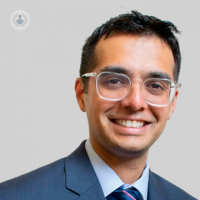Understanding achilles tendinopathy: Insights and solutions
Written in association with:In his latest online article, Mr Shelain Patel gives us his insights into Achilles tendinopathy. He talks about the typical symptoms and how it differs from other foot or ankle conditions, the primary causes, risk factors, what non-surgical treatments and exercises can help manage pain, when surgical intervention is necessary, the different surgical options available and if there are any long-term consequences or complications if the condition is left untreated.

What are the typical symptoms of Achilles tendinopathy, and how is it different from other foot or ankle conditions?
Pain and swelling at the back of the ankle are the hallmarks of Achilles tendinopathy. It differs from other conditions in that the pain can be constant rather than activity related and because of its location, wearing shoes that rub against the back of the heel can be irritable and uncomfortable.
What are the primary causes and risk factors associated with developing Achilles tendinopathy?
There are two types or Achilles tendinopathy: insertional and non-insertional. Insertional tendinopathy occurs where then tendon attaches to the heel bone and is associated with a bump on the heel bone known as Haglund’s bump which irritates the tendon while the ankle moves upwards. Non-insertional tendinopathy occurs higher up and is thought to result from either overuse of a previous injury to the tendon.
What non-surgical treatments and exercises can help manage and alleviate Achilles tendinopathy pain?
Physiotherapy and shockwave therapy form the bulk of non-surgical treatment. For insertional tendinopathy, a short period of using a heel lift in the shoes can help. For non-insertional Achilles tendinopathy, an eccentric stretching programme has been proven to be the most effective treatment. It works by loading the individual tendon fibres to encourage them to heal and re-orientate in the correct alignment.
When is surgical intervention necessary for Achilles tendinopathy, and what are the surgical options available?
Surgery is only indicated when non-surgical treatment has failed. Typically, insertional Achilles tendinopathy is more likely than non-insertional tendinopathy to need an operation since it is a harder condition to get better without an operation. Surgery depends upon the severity of tendon disease and excess bone formation but typically bone and tendon are debrided and the tendon is reattached. In very severe cases, a tendon transfer (where another tendon is sacrificed from its original role) is used to provide additional function to the Achilles tendon.
Are there any long-term consequences or complications if Achilles tendinopathy is left untreated?
In most cases, chronic pain is the only consequence of leaving Achilles tendinopathy untreated. Rarely, failure to treat the condition can make the tendon more swollen and friable which will result in tendon rupture if a sudden force is exerted on it such as a stumble or fall.
Mr Shelain Patel is an esteemed orthopaedic surgeon with over 20 years of experience. You can schedule an appointment with Mr Patel on his Top Doctors profile.


